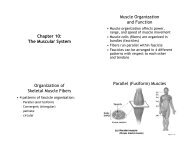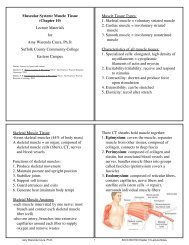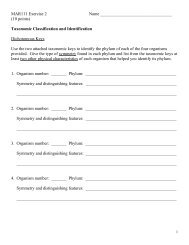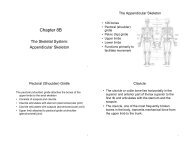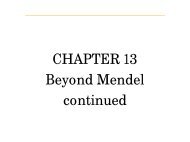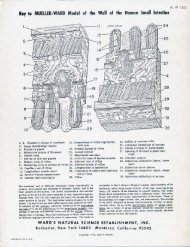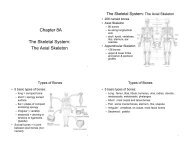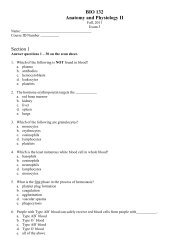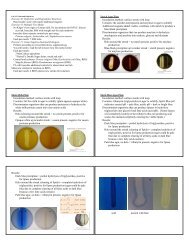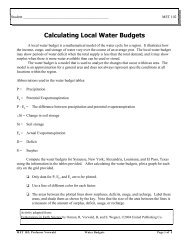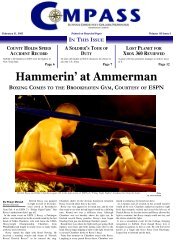Laboratory Exercise: Geologic Time
Laboratory Exercise: Geologic Time
Laboratory Exercise: Geologic Time
You also want an ePaper? Increase the reach of your titles
YUMPU automatically turns print PDFs into web optimized ePapers that Google loves.
Name __________________________________________ ESC 101<br />
<strong>Laboratory</strong> <strong>Exercise</strong>: <strong>Geologic</strong> <strong>Time</strong><br />
Part A: Understanding <strong>Geologic</strong> <strong>Time</strong>.<br />
As you learn about past events in Earth history you may be surprised when you hear that something occurred<br />
“only” a million years ago. In the context of a human lifetime this is an enormous amount of time. Yet, geologists may<br />
consider this to be a short time ago when compared to Earth’s age. The enormity of geologic time is difficult to<br />
understand. One way to help visualize geologic time is to create a time-line.<br />
To illustrate the enormity of geologic time the length of football field will be used as a time-line for geologic<br />
events (Figure 1). Because distances in American football are measured in yards, this analogy will not use metric units of<br />
measure.<br />
The present will be placed on the goal line near the “Geologists” end zone. As we move away from the goal line<br />
towards the “Astronomers” end zone we are moving further into the past. As you move back towards the “Geologists”<br />
goal line you are moving closer to the present. On this scale, one yard is equal to 46 million years. Using this scale the<br />
estimated time of origin of Earth and solar system (4.6 billion years) is 100 yards away, at the “Astronomers” goal line.<br />
You can see that on this scale the extinction of the dinosaurs occurred only 1.4 yards from the present (the “Geologists”<br />
goal line). It must be noted that many scientists believe that not all dinosaurs became extinct. There is evidence that<br />
birds are the last surviving branch of the dinosaurs! Earliest humans lived 2.4 million years ago. This would be only<br />
0.05 yards (1.8 inches) from the present. This illustrates that even a million years isn’t a long time in terms of Earth’s<br />
age. On this scale the length of a football field from goal line to goal line is equal to the entire time Earth has existed.<br />
One million years is equal to only 0.7 inches!<br />
Figure 1: <strong>Geologic</strong> <strong>Time</strong>-Line © Brian Vorwald (2009)<br />
ESC 101: Professor Vorwald <strong>Geologic</strong> <strong>Time</strong> Page 1 of 6
Part A: Understanding the <strong>Geologic</strong> <strong>Time</strong> Scale<br />
In <strong>Laboratory</strong> One in your lab manual read the section, Part 1A on pages 2 and 3, up to the section titled, “Processes and<br />
Cycles of Change.” Also study the <strong>Geologic</strong> <strong>Time</strong> Scale, Figure 1.3 on page 4. All Earth history has been organized into<br />
what is called the geologic time scale, which like a calendar. In this calendar we can refer to many events and rock units.<br />
As in a calendar, the geologic time scale has subdivisions with longer time periods being broken into smaller time<br />
periods. The basis for these subdivisions is the fossil record and extinctions.<br />
1. The Precambrian the an informal name for geologic time from Earth’s origin up to 542 million years ago.<br />
a. List the names of the eons that comprise the Precambrian, starting with the oldest eon.<br />
____________________ ___________________ ____________________<br />
Age decreases (closer to the present)<br />
b. The graph below (Figure 2) represents the percentage of time for each of the major eons.<br />
Figure 2 - The Eons of <strong>Geologic</strong> <strong>Time</strong><br />
Find the percent of total Earth History represented by the geologic time units using the directions listed<br />
below. Record your answers in Table 1.<br />
# The angular measure of each time interval in the pie graph has been determined and is listed in<br />
Table 1.<br />
# Find the percentage of the circle for each eon using the following equation:<br />
Percentage = Measured Angle in degrees X 100<br />
360 degrees<br />
Table 1<br />
<strong>Time</strong> Unit Measured Angle Calculations Percent<br />
Cenozoic Era 5 o<br />
Mesozoic Era 14 o<br />
Paleozoic Era<br />
22 o<br />
Precambrian Eon 319 o<br />
c. Explain why <strong>Geologic</strong> <strong>Time</strong> Scale shown in Figure 1.3 is not accurately constructed.<br />
ESC 101: Professor Vorwald <strong>Geologic</strong> <strong>Time</strong> Page 2 of 6
2. Which is the largest subdivision of time? (Eon, era, period, epoch)<br />
3. What is the name for the oldest eon? _____________________________<br />
4. List the periods of the Mesozoic Era starting with the oldest period. _____________________________<br />
5. Which period ended 416 Ma?<br />
6. Which period started 200 Ma?<br />
7. Eons, eras, periods, and epochs of time are used to group events and relationships of geologic time. What do<br />
enothems, erathems, systems, and series rock represent?<br />
________________________________________________________________________________________<br />
8. Determine the total duration of time for the Paleozoic Era. ____________________<br />
Show work here <br />
9. Based on Table 1 and Figure 1.3, what percentage of Earth history is well documented by fossils? _______ %<br />
Show work here <br />
Part B: Historical <strong>Time</strong> Grid Model for <strong>Geologic</strong> <strong>Time</strong><br />
Figure 3 is a grid representing the last millennium. In this model, you will determine how many pieces of paper, each<br />
representing 1,000 years it would take to represent all of Earth history. Then if you were to place each piece of paper<br />
representing 1,000 years of Earth history one on top of the other, you will find how high the stack of paper would be.<br />
1. On the “Historical <strong>Time</strong> Grid”, each box represents one year and the entire grid represents 1,000 years.<br />
# Plot each of the historical events listed in Table 2 on the gridsheet by placing an X in the appropriate box.<br />
# Note that the millennium starts with the year 1001 and the box is labeled with an S. The millennium ends<br />
with 2000 (labeled with an E). When determining the date for each box count from right to left.<br />
Table 2<br />
Column 1 Column 2<br />
Date Event Date Event<br />
Your birth date 1776 Declaration of Independence signed<br />
1976 Viking I land on Mars 1620 Pilgrims land in New England<br />
1969 First Men landed on the Moon 1453 Hundred Years War ended<br />
1963 President John F. Kennedy Assassinated 1337 Hundred Years War began<br />
1945 End of World War II 1215 Magna Carta signed<br />
1918 End of World War I 1095 Pope Urban II called for the Crusades<br />
1865 End of the Civil War 1066 William of Normandy conquered England<br />
2. The height of gridsheets stacked one on another for selected events<br />
Table 3 shows several important geologic events. Because they will not fit on one gridsheet, it will be necessary<br />
to calculate the number of gridsheets that will represent the number of years before the present for each event<br />
using the following steps. Record all data in Table 3.<br />
ESC 101: Professor Vorwald <strong>Geologic</strong> <strong>Time</strong> Page 3 of 6
a. Determine the number of gridsheets for each event. Since one gridsheet represents 1,000 years divide the<br />
number of years by 1,000.<br />
b. Paper Height: Because the thickness of each piece of paper is so small, we will measure the paper height<br />
using reams (packages) of paper. Each ream has 500 gridsheets and is 5.0 cm thick.<br />
# Determine how many reams of paper would be needed for each event by dividing the number of<br />
gridsheets by 500.<br />
# Find the height of the reams by multiplying the number of reams by 5.<br />
# Convert the ream height to meters. Since one meter is equal to 100 cm, divide the height in<br />
centimeters by 100.<br />
Table 3<br />
Events <strong>Time</strong> in<br />
Years Before<br />
the Present<br />
Farthest advance of last glacial ice 22,000<br />
st 1 Pleistocene glacial advance 1,000,000<br />
First ancestral human, Homo<br />
Habilis (First member of the genus<br />
Homo)<br />
Extinction of “non-avian”<br />
dinosaurs<br />
2,400,000<br />
65,000,000<br />
Earliest Dinosaurs 232,000,000<br />
Beginning of Cambrian Period 544,000,000<br />
Oldest rocks found on Earth 4,280,000,000<br />
Age of Earth 4,600,000,000<br />
Number of<br />
Gridsheets<br />
Reams<br />
of Paper<br />
Ream Height<br />
centimeters meters<br />
Questions:<br />
1. For about what percent of Earth’s total history have humans (represented by the genus Homo) been in<br />
existence. Show your calculations below.<br />
_________ %<br />
2. Compare Earth’s age to the age of the oldest Earth rocks found.<br />
3. How many reams of paper would be needed for the total time non-avian dinosaurs _______reams<br />
existed on Earth? Show your calculations below.<br />
4. How does the existence of humans compare with Earth’s age?<br />
ESC 101: Professor Vorwald <strong>Geologic</strong> <strong>Time</strong> Page 4 of 6
E<br />
Historical <strong>Time</strong> Grid<br />
From Explorations in Earth Science by Osmun R, Vorwald B, and Wegner S., UPCO: ©2007.<br />
Preprinted with permission<br />
ESC 101: Professor Vorwald <strong>Geologic</strong> <strong>Time</strong> Page 5 of 6<br />
S
Part C: Radiometric Dating<br />
Complete Activity 8.3 in <strong>Laboratory</strong> Eight of your laboratory manual. It is found on page 190. Use the lab manual page<br />
as a draft and copy your final answers into the spaces shown below. Activity 8.2 is on the other side of the page and you<br />
will need it for a future lab. Consequently, leave it in your lab manual.<br />
A. 1. __________________<br />
2. __________________ yr<br />
Calculations:<br />
3. ____________________________________________________________________________________<br />
4. ____________________________________________________________________________________<br />
B. Earth’s Age: ____________<br />
Reasoning:___________________________________________________________________________________<br />
C. 1. ______________<br />
Explanation: ______________________________________________________________________________<br />
2. _________________________________________________________________________________________<br />
D. 1. _________<br />
_________________________________________________________________________________________<br />
2. (Hint: This is the problem with dating sedimentary rocks.)<br />
_________________________________________________________________________________________<br />
E. 1. _________________________________________________________________________________________<br />
2. _________________________________________________________________________________________<br />
ESC 101: Professor Vorwald <strong>Geologic</strong> <strong>Time</strong> Page 6 of 6



